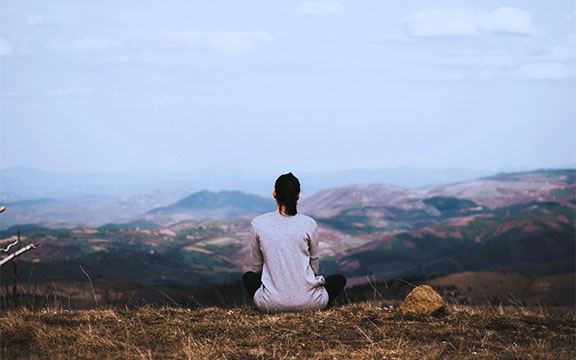
Photo by Milan Popovic via Unsplash.
Who am I really? Who am I being? These are two queries and discoveries to be made while practicing svadhyaya (self-study)—Yoga’s fourth niyama, as well as the second practice in the Kriya Yoga of Sri Patanjali. Svadhyaya includes the study of sacred texts and the practice of Self-inquiry, contemplating the nature of one’s essential being. This profound practice invites one to journey beyond the mind and senses to the truth of who we are.
As much as the ego may have served us as a useful protector when we were growing up, as adults it is a double-edged sword. The ego weaves stories often based on childhood and cultural influences that can negatively affect our ways of thinking and feeling. The ego can also seem to veil or block access to our true identity. Through the practice of svadhyaya, we learn to recognize and understand how ego-conditioning affects various aspects of our life. We may even learn that spiritual teachings can be appropriated by the ego.
By studying sacred texts that enable us to understand their true nature and by reflecting on our thoughts, actions, and motivations, we cultivate greater insights and self-awareness. Svadhyaya helps us to recognize our patterns of behavior and make conscious choices to align with our true Self rather than our ego.
So, what does it look like to embark on a a study of the “Self?” What does it feel like? Well, to me, it feels like I’ve been given a gift from the Divine—the gift of opening the door to endless possibilities and opportunities by helping me to recognize who I really am. I have learned to disconnect and cut the cords of bad habits I practiced for a long time, seeing how those did not serve me. Procrastination, was one of those habits and it is not something that want to entertain again. Before I began practicing svadhyaya, I found myself playing out a “victim” role, which was a sure fire way for me to avoid life and to downplay my dreams, keeping me from living up to my potential and making it easier to disconnect from myself.
When we choose to make Yoga a way of life, we not only learn, but also experience, significant growth from the seeds sown along the journey. Svadhyaya enables us to experience a profound transformation as it cleanses the mind, body, breath, and spirit of toxic thoughts and actions. I began to learn how my body reacts to life’s experiences, especially when stress is involved. The breath is often able to reveal our state of mind. We get to listen and notice our breathing pattern and learn from it. For example, shallow breath is a clear indicator that there’s some level of stress felt in the body, as well as the feeling of an “elephant’s foot” on the chest that may have been triggered from holding the breath. In either situation, the sympathetic nervous system, fight or flight takes effect. Whether it is physical, mental or emotional, we tend to run away without hesitation.
The more we learn about ourselves the sooner we can heal and live in the present. We get to experience both the calming and healing effects of the parasympathetic nervous system by reconditioning our mind, discerning narratives from reality, and maintaining a daily practice that encompasses the mind, body, breath and spirit. In addition, Yoga’s foundational ethics are a great resource to help calm and ground ourselves allowing it to inspire us to live with determination and intention, stepping into who we truly are. Through Yoga practice, we develop more understanding about how to break vicious cycles of unwanted habits. As we deepen our practice on the mat through asana, we continue off the mat to work through distractions and avoid reverting to old habits that do not serve our highest good—like binging on food, movies, social media platforms, etc. or whatever that may look like for each of us.
As we engage more and more deeply with the bounty of Yoga practices—the foundation of Yoga ethics and yogic mindset utilizing Raja Yoga, asanas (physical postures), pranayama (breath practices), and meditation, we get to stay connected to a transformative lifestyle and a discipline that helps to ground us, like a live oak tree standing strong with its broad canopy and arching branches, resistant to breakage and withstanding the toughest storms. When we are steadfast in learning a discipline like the yamas and niyamas (Yoga’s ethics), we reap the benefits of the yogic lifestyle in that it is always available to us, uplifting and inspiring us. Svadhyaya enables us to cultivate stronger roots that can sustain us.
Now, I am learning to fulfill my dreams by not allowing the high tides of fear to pull me into avoidance or despair. One of my affirmations is, “Learn to live around fear and not in it.” When I feel anxiety or stress poking through, I ask myself, “What does love say? What action does love want me to take?” In this learning process, I was able to feel the light bulb turn on and experience a clearer perspective of what my vision for my life is and for my contribution to the world.
As Swami Satchidananda once stated, “The light is within. It is already there. Take your time to see it.” So, in practicing svadhyaya, I regularly ask myself: “Who am I really? Who am I being?” At the highest level of my understanding, I am the Self, pure Consciousness. On the relative level, I am an authentic, compassionate, inspirational teacher. My vision for the world is connection—to connect in a space of respect, love, compassion, and peace. It is my belief that we all have a purpose here on planet Earth. I live my life’s purpose with unconditional love, enthusiasm, and gratitude. I am a loving and compassionate facilitator of peace through my service to others. With love and gratitude, I support, uplift, and uphold those in my life, as we get to experience a harmonious community. Each stepping stone brings me closer to a life of balance, peace and joy.
Indubitably, our intimate relationship with who we are is our greatest gift and treasure. When we begin to recognize the truth of who we essentially are, we also can begin to experience this as a lived understanding, a felt understanding. So, I invite you to ask yourself, “Who am I?” and “Who am I being?”
About the Author:
 Elizabeth Saranya Sostre returned to her love for Yoga and writing during the time she took ill with Stage 3 Non-Hodgkin’s Lymphoma, in 2009. Upon learning she could not return to her career as an educator for the Department of Education, she took time to rediscover herself. As she continued her new journey, she developed interest in several healing modalities, which led her to becoming a Reiki master, Yoga teacher, life and holistic health coach, and a transformational trainer. She joined the Integral Yoga Institute family in New York as a karma yogi before the commencement of her employment at the front desk and as the Wellness Sanctuary Manager. She attended IYI’s 200hr. Teacher Training and is both excited and passionate about teaching a Hatha Yoga Level I class. Liz is currently writing a book, Deconstructing Your Past To Live In The Present.
Elizabeth Saranya Sostre returned to her love for Yoga and writing during the time she took ill with Stage 3 Non-Hodgkin’s Lymphoma, in 2009. Upon learning she could not return to her career as an educator for the Department of Education, she took time to rediscover herself. As she continued her new journey, she developed interest in several healing modalities, which led her to becoming a Reiki master, Yoga teacher, life and holistic health coach, and a transformational trainer. She joined the Integral Yoga Institute family in New York as a karma yogi before the commencement of her employment at the front desk and as the Wellness Sanctuary Manager. She attended IYI’s 200hr. Teacher Training and is both excited and passionate about teaching a Hatha Yoga Level I class. Liz is currently writing a book, Deconstructing Your Past To Live In The Present.
